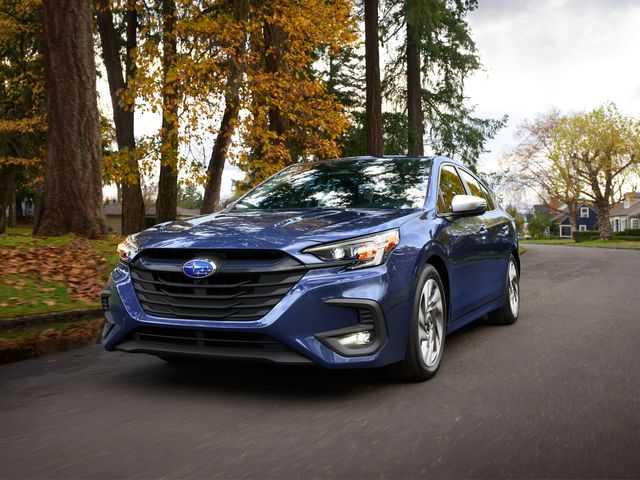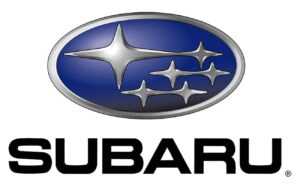 Subaru Legacy 2023 Fuel Touring XT
Subaru Legacy 2023 Fuel Touring XT
The cutting-edge fuel system of the 2023 Subaru Legacy Touring XT creates a balanced blend of efficiency and performance. With its strong 2.4-liter turbocharged engine, this model performs well in terms of power delivery and competitive fuel economy. The Legacy Touring XT uses standard unleaded gasoline as fuel and is equipped with contemporary fuel-saving features, such as an automated start-stop system that reduces engine braking to improve efficiency. Subaru’s careful engineering guarantees effective fuel delivery and combustion, and its selectable driving modes offer drivers the ability to tailor their driving experience to maximize performance and fuel efficiency. This blend of capability, style, and environmental friendliness highlights the Legacy Touring XT’s dedication to providing a comprehensive driving experience.
2024 Subaru Legacy Specs, Price, Features, Mileage (Brochure)
Fuel
CAUTION
- The use of a fuel that is low in quality or the use of an inappropriate fuel additive may cause damage to the engine and/or fuel system.
- Some gas stations, particularly those in high-altitude areas, offer fuels posted as regular octane gasoline with an octane rating below 87 AKI (90 RON).
- The use of those fuels is not recommended.
Fuel Requirements
The engine is designed to operate using unleaded gasoline with an octane rating of 87 AKI (90 RON) or higher.
NOTE
When using the 2.4 L turbo engine model to tow a trailer, SUBARU recommends using unleaded gasoline with an octane rating of 91 AKI (95 RON) or higher to reduce the risk of engine overheating.
Fuel octane rating
Using gasoline with a lower octane rating can cause persistent and heavy knocking, which can damage the engine. Do not be concerned if your vehicle sometimes knocks lightly when you drive up a hill or when you accelerate. See your dealer or a qualified service technician if you use fuel with the specified octane rating and your vehicle knocks heavily or persistently.
RON
This octane rating is the Research Octane Number.
AKI
This octane rating is the average of the Research Octane and Motor Octane numbers and is commonly referred to as the Anti Knock Index (AKI).
Unleaded gasoline
The neck of the fuel filler pipe is designed to accept only an unleaded gasoline filler nozzle. Under no circumstances should a leaded gasoline be used because it will damage the emission control system and may impair driving ability and fuel economy.
Reformulated gasoline
SUBARU supports the use of reformulated gasoline when available. Reformulated gasoline has been blended to burn more cleanly and reduce vehicle emissions.
MMT
Some gasoline contains an octane-enhancing additive called MMT (Methylcyclopentadienyl Manganese Tricarbonyl). If you use such fuels, your emission control system performance may deteriorate and the CHECK ENGINE warning light/malfunction indicator light may turn on. If this happens, return it to your authorized SUBARU Dealer for service. If it is determined that the condition is caused by the type of fuel used, repairs may not be covered by your warranty.
Gasoline for cleaner air (2.4 L models)
Your use of gasoline with detergent additives will help prevent deposits from forming in your engine and fuel system. This helps keep your engine in tune and your emission control system working properly and is a way of doing your part for cleaner air. If you continuously use high-quality fuel with the proper detergent and other additives, you should never need to add any fuel system cleaning agents to your fuel tank. Many types of gasoline are now blended with materials called oxygenates. The use of these fuels can also help keep the air cleaner. Oxygenated blend fuels, such as ethanol(ethyl or grain alcohol) may be used in your vehicle but should contain no more than 15% ethanol for the proper operation of your SUBARU. Do not use any gasoline that contains more than 15% ethanol, including from any pump labeled E30, E50, or E85 (which are only some examples of fuel containing more than 15% ethanol). In addition, some gasoline suppliers are now producing reformulated gasoline, which is designed to reduce vehicle emissions. SUBARU approves the use of reformulated gasoline. If you are not sure what the fuel contains, you should ask your service station operators if their gasoline contains detergents and oxygenates and if they have been reformulated to reduce vehicle emissions. As additional guidance, only use fuels suited for your vehicle as explained in the following description.
- Fuel should be unleaded and have an octane rating no lower than that specified in this manual.
- Methanol (methyl or wood alcohol) is sometimes mixed with unleaded gasoline. Methanol can be used in your vehicle ONLY if it does not exceed 5% of the fuel mixture AND if it is accompanied by sufficient quantities of the proper solvents and corrosion inhibitors required to prevent damage to the fuel system.
- Do not use fuel containing methanol EXCEPT under these conditions.
- If undesirable driveability problems are experienced and you suspect they may be fuel-related, try a different brand of gasoline before seeking service at your SUBARU dealer.
- Fuel system damage or driveability problems that result from the use of improper fuel are not covered under the SUBARU Limited Warranty.
Gasoline for cleaner air (2.5 L models)
Your use of gasoline with detergent additives will help prevent deposits from forming in your engine and fuel system. This helps keep your engine in tune and your emission control system working properly and is a way of doing your part for cleaner air. If you continuously use high-quality fuel with the proper detergent and other additives, you should never need to add any fuel system cleaning agents to your fuel tank. Many types of gasoline are now blended with materials called oxygenates. The use of these fuels can also help keep the air cleaner. Oxygenated blend fuels, such as ethanol (ethyl or grain alcohol) may be used in your vehicle but should contain no more than 10% ethanol for the proper operation of your SUBARU. Do not use any gasoline that contains more than 10% ethanol, including from any pump labeled E15, E30, E50 or E85 (which are only some examples of fuel containing more than 10% ethanol). In addition, some gasoline suppliers are now producing reformulated gasoline, which is designed to reduce vehicle emissions. SUBARU approves the use of reformulated gasoline. If you are not sure what the fuel contains, you should ask your service station operators if their gasoline contains detergents and oxygenates and if they have been reformulated to reduce vehicle emissions. As additional guidance, only use fuels suited for your vehicle as explained in the following.
- Fuel should be unleaded and have an octane rating no lower than that specified in this manual.
- Methanol (methyl or wood alcohol) is sometimes mixed with unleaded gasoline. Methanol can be used in your vehicle
ONLY if it does not exceed 5% of the fuel mixture AND if it is accompanied by sufficient quantities of the proper solvents and corrosion inhibitors required to prevent damage to the fuel system. Do not use fuel containing methanol EXCEPT under these conditions.
- If undesirable driveability problems are experienced and you suspect they may be fuel-related, try a different brand of gasoline before seeking service at your SUBARU dealer.
- Fuel system damage or driveability problems that result from the use of improper fuel are not covered under the SUBARU Limited Warranty.
Fuel Filler Lid and Cap
Locations of the fuel filler lid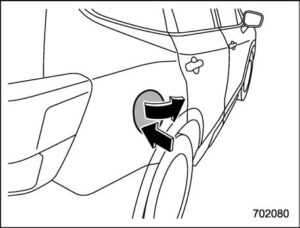
Refueling
Only one person should be involved in refueling. Do not allow others to approach the area of the vehicle near the fuel filler pipe while refueling is in progress. Be sure to observe any other precautions that are posted at the service station.
- Stop the vehicle, turn the ignition switch to the “LOCK”/ “OFF” position, and turn off all the other electrical components.
- To unlock the fuel filler lid, perform one of the operations below.
- Press the “ ” button on the key fob.
- Press the unlock side of the power door locking switch.
- Push the rear side of the fuel filler lid.
- The fuel filler lid opens automatically.
- Open it further by hand.
WARNING
Before opening the fuel filler cap, first touch the vehicle body or a metal portion of the fuel pump or similar object to discharge any static electricity that may be present on your body. If your body is carrying an electrostatic charge, there is a possibility that an electric spark could ignite the fuel, which could burn you. To avoid acquiring a new static electric charge, do not get back into the vehicle while refueling is in progress.
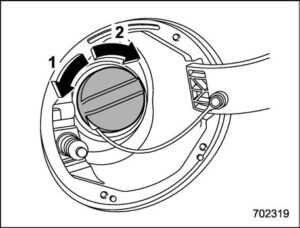
- Open
- Close
- Remove the fuel filler cap by turning it slowly counterclockwise.
WARNING
- Gasoline vapor is highly flammable. Before refueling, always turn the ignition switch to the “LOCK”/“OFF” position first and then close all vehicle doors and windows. Make sure that there are no lighted cigarettes, open flames or electrical sparks in the adjacent area. Only handle fuel outdoors. Quickly wipe up any spilled fuel.
- When opening the cap, grasp it firmly and turn it slowly to the left. Do not remove the cap quickly. Fuel may be under pressure and spray out of the fuel filler neck, especially in hot weather. If you hear a hissing sound while you are removing the cap, wait for the sound to stop and then slowly open the cap to prevent fuel from spraying out and creating a fire hazard.

- Set the fuel filler cap on the cap holder inside the fuel filler lid.
- When refueling, insert the fuel nozzle securely into the fuel filler pipe. If the nozzle is lifted or not fully inserted, its automatic stop-ping mechanism may not function, causing fuel to overflow the tank and creating a fire hazard.
- Stop refueling when the automatic stop mechanism on the fuel nozzle activates. If you continue to add fuel, temperature changes or other conditions may cause fuel to overflow from the tank and create a fire hazard.
- Stop filling the tank after the fuel filler pump automatically stops. Do not add any more fuel
- Put the cap back on and turn it clockwise until you hear a clicking noise. Be certain not to catch the tether under the cap while tightening.
CAUTION
Make sure that the cap is tightened until it clicks to prevent fuel spillage in the event of an accident.
- Close the fuel filler lid completely.
CAUTION
Do not let fuel spill on the exterior surfaces of the vehicle. Because fuel may damage the paint, be sure to wipe off any spilled fuel quickly. Paint damage caused by spilled fuel is not covered under the SUBARU Limited Warranty.
NOTE
- You will see the sign in the fuel gauge. This indicates that the fuel filler lid is located on the right side of the vehicle.
- If the fuel filler cap is not tightened until it clicks or if the tether is caught under the cap, the CHECK ENGINE warning light/malfunction indicator light may illuminate.
- To lock the fuel filler lid, perform one of the operations below. However, if these operations are performed when the fuel filler lid is open, the fuel filler lid will not lock when it is subsequently closed.
- Press the button on the key fob.
- Press the lock side of the power door locking switch.
- When the doors are locked or unlocked using the automatic door lock system, the fuel filler lid will be locked or unlocked at the same time.
CAUTION
- Never add any cleaning agents to the fuel tank. The addition of a cleaning agent may cause damage to the fuel system.
- After refueling, turn the cap to the right until it clicks to ensure that it is fully tightened. If the cap is not securely tightened, fuel may leak out while the vehicle is being driven or fuel spillage could occur in the event of an accident, creating a fire hazard.
- Do not let fuel spill on the exterior surfaces of the vehicle. Because fuel may damage the paint, be sure to wipe off any spilled fuel quickly. Paint damage caused by spilled fuel is not covered under the SUBARU Limited Warranty.
- Always use a genuine SUBARU fuel filler cap. If you use the wrong cap, it may not fit or have proper venting and your fuel tank
and emission control system may be damaged. It could also lead to fuel spillage and a fire. - Immediately put fuel in the tank whenever the low fuel warning light illuminates. Engine misfires as a result of an empty tank could cause damage to the engine. Continuing to operate your vehicle at an extremely low fuel level may result in a reduction of engine performance.
If the fuel filler lid cannot be opened (Legacy)
If the fuel filler lid cannot be opened due to a malfunction or a dead battery, it can be opened from the trunk.

Remove the access cover at the right side of the trunk trim.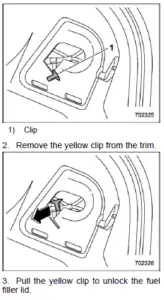
If the fuel filler lid cannot be opened (Outback/Subaru Outback Wilderness)
If the fuel filler lid cannot be opened due to a malfunction or a dead battery, it can be opened from the cargo area.
Remove the access cover at the right side of the cargo area trim using a flathead screwdriver.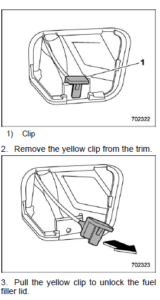
State Emission Testing (U.S. Only)
Only use a four-wheel dynamometer when testing an All-Wheel Drive (AWD) model. Testing of an AWD model must NEVER be performed on a single two-wheel dynamometer. Attempting to do so will result in uncontrolled vehicle movement and may cause an accident or injuries to persons nearby.
CAUTION
- At state inspection time, remember to tell your inspection or service station in advance not to place your SUBARU AWD vehicle on a two-wheel dynamometer. Otherwise, serious transmission damage will result.
- Resultant vehicle damage due to improper testing is not covered under the SUBARU Limited Warranty and is the responsibility of the state inspection program or
its contractors or licensees.
California and a number of federal states have Inspection/Maintenance programs to inspect your vehicle’s emission control system. If your vehicle does not pass this test, some states may deny renewal of your vehicle’s registration. Your vehicle is equipped with a computer that monitors the performance of the engine’s emission control system. Certified emission inspectors will inspect the onboard diagnostic (OBDII) system as part of the state emission inspection process. The OBDII system is designed to detect engine and transmission problems that might cause vehicle emissions to exceed allowable limits. OBDII inspections apply to all 1996 model year and newer passenger cars and trucks. Over 30 states plus the District of Columbia have implemented emission inspection of the OBDII system.
- The inspection of the OBDII system consists of a visual operational check of the “CHECK ENGINE” warning light/malfunction indicator light (MIL) and an examination of the OBDII system with an electronic scan tool.
- A vehicle passes the OBDII system inspection if proper operation of the “CHECK ENGINE” warning light/malfunction indicator light (MIL) is observed, there are no stored diagnostic trouble codes, and the OBDII readiness monitors are all complete.
- A vehicle fails the OBDII inspection if the “CHECK ENGINE” warning light/malfunction indicator light (MIL) is not properly operating (the light is illuminated or is not working due to a burned-out bulb) or there is one or more diagnostic trouble codes stored in the vehicle’s computer.
- A state emission inspection may reject (not pass or fail) a vehicle if the number of OBDII system readiness monitors “NOT READY” is greater than one. If the vehicle’s battery has been recently replaced or disconnected, the OBDII system inspection may indicate that the vehicle is not ready for the emission test. Under this condition, the vehicle driver should be instructed to drive his/her vehicle for a few days to reset the readiness monitors and return for an emission re-inspection.
- Owners of rejected or failing vehicles should contact their SUBARU Dealer for service.
Some states still use dynamometers in their emission inspection program. A dynamometer is a treadmill or roller-like testing device that allows your vehicle’s wheels to turn while the vehicle remains in place. Before your vehicle being put on a dynamometer, tell your emission inspector not to place your SUBARU AWD vehicle on a two-wheel dynamometer. Otherwise, serious transmission damage will result. - The U.S. Environmental Protection Agency (EPA) and states using two-wheel dynamometers in their emission testing program have EXEMPTED SUBARU AWD vehicles from the portion of the testing program that involves a two-wheel dynamometer. Some states use four-wheel dynamometers in their testing program. When properly used, this equipment should not damage a SUBARU AWD vehicle.
Under no circumstances should the rear wheels be jacked off the ground, nor should the driveshaft be disconnected in an attempt to bypass AWD for state emission testing. An AWD vehicle must be tested using an AWD dynamometer with all 4 wheels driven and loaded.
Preparing to Drive
You should perform the following checks and adjustments every day before you start driving.
- Check that all windows, mirrors, and lights are clean and unobstructed.
- Check the appearance and condition of the tires. Also, check tires for proper inflation.
- Look under the vehicle for any sign of leaks.
- Check that no small animals enter the engine compartment.
- Check that the hood, trunk (Legacy), and rear gate (Outback/Subaru Outback Wilderness) are fully closed.
- Check the adjustment of the seat.
- Check the adjustment of the inside and outside mirrors.
- Fasten your seatbelt. Check that your passengers have fastened their seatbelts.
- Check the operation of the warning and indicator lights when the ignition switch is turned to the “ON” position.
- Check the gauges, indicator, and warning lights after starting the engine.
CAUTION
Trapping small animals in the cooling fan and belts of the engine may result in a malfunction. Check that no small animal enters the engine compartment and under the vehicle before starting the engine.
NOTE
- Engine oil, engine coolant, brake fluid, washer fluid, and other fluid levels should be checked daily, weekly, or at fuel stops.
FAQ
The Touring XT typically uses regular unleaded gasoline.
Yes, the Touring XT features a 2.4-liter turbocharged engine that may provide robust performance while maintaining respectable fuel efficiency.
Fuel economy figures can vary based on driving conditions and other factors, but the Touring XT is expected to offer competitive fuel efficiency for its class, with city and highway estimates available from Subaru.
Yes, it is equipped with an automatic start-stop system, which temporarily shuts off the engine when the vehicle is stopped, enhancing fuel efficiency.
The exact fuel tank capacity may vary, but it’s typically in the range of 18 to 19 gallons.
Subaru employs advanced fuel injection and engine management systems to optimize fuel delivery and combustion for improved efficiency.
Many modern vehicles, including the Legacy Touring XT, offer driving modes that allow the driver to select between various settings, potentially affecting fuel efficiency and performance.
It may offer driving modes that emphasize fuel efficiency, adapting throttle response and other parameters to maximize mpg.
Routine maintenance includes fuel filter replacement and fuel system inspections to ensure optimal performance and cleanliness.
Features like the automatic start-stop system and driving modes can help promote eco-friendly driving habits, conserving fuel and reducing emissions.
Practicing smooth acceleration and braking, maintaining proper tire pressure, and avoiding excessive idling can all contribute to improved fuel efficiency.
The Touring XT typically runs on regular gasoline, but Subaru offers hybrid powertrains in some models for those seeking alternative fuel options.
The Continuously Variable Transmission (CVT) in the Touring XT is designed to optimize fuel efficiency by continuously adjusting gear ratios to match driving conditions.
Subaru engineers the Touring XT to maintain competitive fuel efficiency in both city and highway driving scenarios, with the CVT playing a key role in this balance.
Many vehicles, including the Touring XT, offer a digital display that shows real-time fuel economy to help drivers adjust their driving habits for better efficiency.
Useful Link
View Full User Guide: Subaru Legacy 2023 Touring XT User Guide
Download Manuals: https://www.subaru.com/owners/vehicle-resources/manuals.html
2024 Subaru Legacy Specs, Price, Features, Mileage (Brochure)

